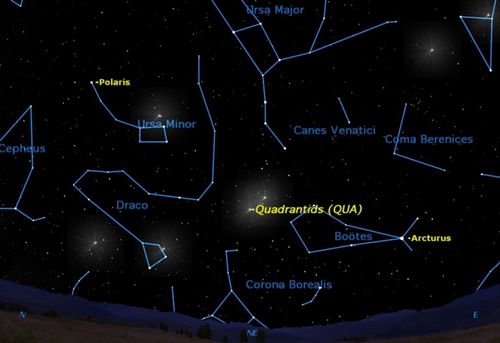If you have trouble sleeping, or if you are into this sort of thing, try to step outside at 3 am. (You can of course go out earlier and later, but 3 am is peak time):
Meteor watchers in North America can expect to see 60 to 200 meteors an hour streak across the sky early Wednesday.
NASA says the Quadrantid meteor shower should be perfect for viewing around 3 a.m. local time Wednesday after the waxing gibbous moon sets.
But the light show won't last long, NASA says – only a few hours.
The Quadrantids were first noted in 1825 and got their name from the constellation of Quadrans Muralis, which is no longer considered a constellation by astronomers, according to NASA.
The material that is burning up in Earth's atmosphere during the Quadrantids likely comes from a comet that broke into fragments centuries ago, NASA says.
"After hundreds of years orbiting the sun, they will enter our atmosphere at 90,000 mph, burning up 50 miles above Earth's surface," a NASA press release says.
If you've never see a meteror shower, you really need to.
UPDATE: More on the Quadrintids…(in response to comments below)
Just to reiterate, this will peak tomorrow (Wednesday) morning as early as 2 am. That's the peak time — you could probably see meteors earlier, but it will be a random one or two here and there. That's not only because there will be fewer meteors, but also because the moon might blot them out. At peak time, however, you can spot (ideally) 60 to 120 per minute, not only because there will be more of them, but also because the moon will have set. And viewing favors the east coast.
This is the star map…
Don't worry if you don't know your way around the sky. After all, this only shows where the meteors will emanate from. If you look generally to the north or northeast sky at peak, and wait (let your eyes adjust and of course, the darker spot away from the city the better, you'll see them.)


